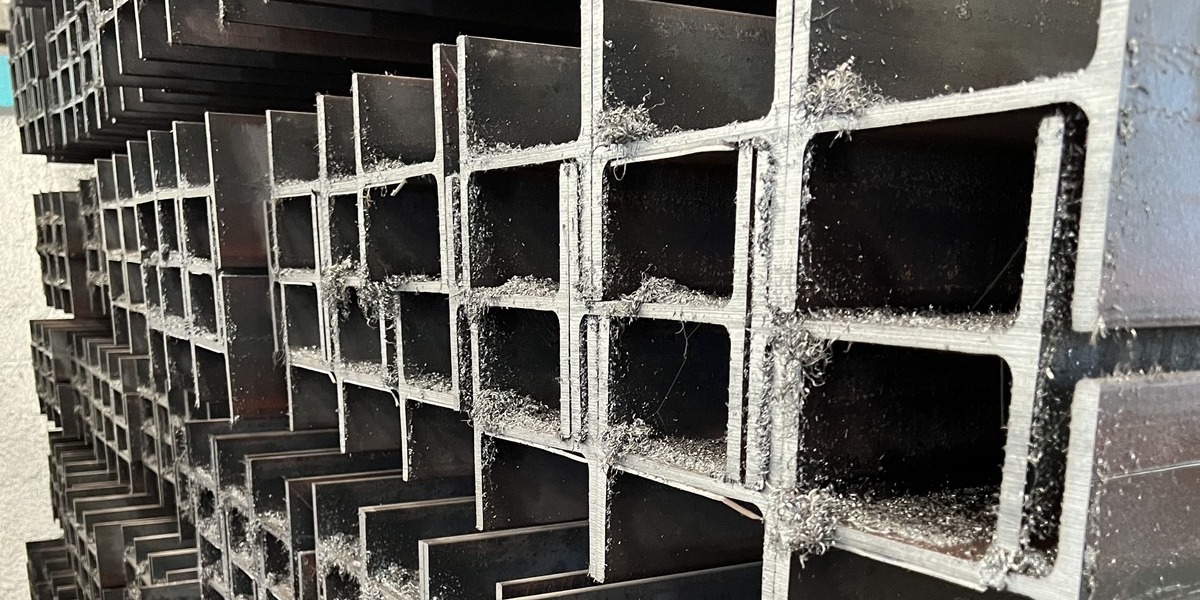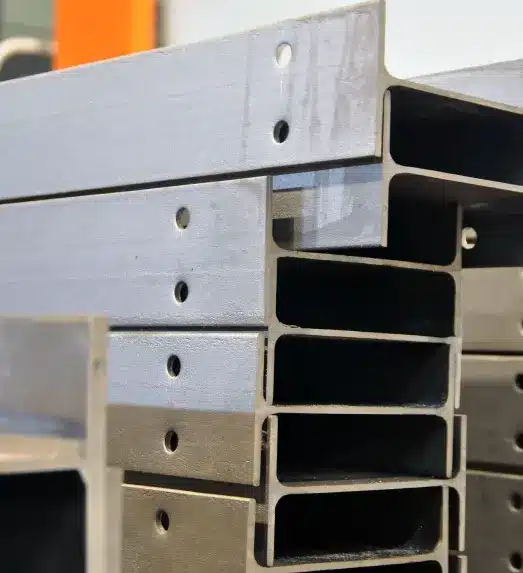Construction is a complex industry with a lot of moving pieces and many different processes involved to achieve the ultimate goal of any project.
Among them, cut-to-size, galvanizing, and punching are three of the most essential processes. Understanding how these processes work and their benefits can help construction professionals make informed decisions about their projects.
In this article, we will explain what cut to size, galvanizing, and punching are and how they can benefit your construction project.
Cut-to-size (Saw Cut)
Cut to size is the process of cutting metal products to the exact size and shape required for a construction project.
In construction, this is often done using a saw, which allows for greater accuracy and control.
This process is important for ensuring that materials fit together perfectly, thus reducing waste and minimizing the need for on-site modifications. Elements that commonly go through this process include joists, beams, or rafters.
Cut to size is commonly used for steel and aluminum products, such as sheets, plates, and bars.
Choosing the right saw for the job is essential for achieving accurate cuts and minimizing waste. This is why you should always put the needs of your projects in the hands of experts.
Benefits of Cut to Size
Using cut-to-size materials in construction has numerous benefits that make it a popular choice among different project developers. Here are some of the biggest advantages:
1. Cost-effective: Cut-to-size materials can help reduce waste and minimize material expenses. This is because they are precision-cut to fit specific dimensions, meaning there is very little unused material left over.
2. Increased efficiency: When using pre-cut materials, builders can save time and effort on measuring, marking, and cutting. This results in faster construction times and increased productivity. On-site modifications are minimized.
3. Enhanced precision: Cut-to-size materials are crafted with precision machinery that guarantees accurate sizing and perfect edges. This means that the pieces will fit together flawlessly, creating a high-quality finished product.
4. Reduced risk of errors: Measuring and cutting materials on site can be a daunting task, especially for less experienced builders. Cut-to-size materials offer a level of accuracy and uniformity that reduces the risk of errors and mistakes.
5. Environmentally friendly: As mentioned earlier, cut-to-size materials reduce waste, which in turn reduces the environmental impact of construction projects.
Galvanizing
Galvanizing is the process of applying a protective coating of zinc to steel or iron products to prevent corrosion and increase longevity.
This is important in construction, where metals are often exposed to the elements and can quickly rust and degrade.
Therefore, this process is commonly used for outdoor applications, such as structural steel, fences, and guardrails.
Galvanizing can be done through hot-dip or electroplating methods.
Hot-dip galvanizing is the most common method and involves dipping the metal into a bath of hot, molten zinc. The zinc adheres to the metal and creates a protective layer that prevents rust and corrosion.
Electroplating, also called electro-galvanizing, is a similar process but uses an electrical current to deposit the zinc onto the metal.
An interesting fact is that galvanized materials are also fire-resistant and have a higher resistance to mechanical damage than uncoated metals.
Benefits of Galvanizing
Galvanizing is a great choice for construction purposes, and here are some of its most significant benefits:
1. Corrosion Resistance: Corrosion-free structures are essential for any construction project, and galvanizing provides the best possible resistance against rust. Unlike other coatings, galvanized steel can withstand the test of time and ensure longevity.
2. Cost-Effective: The overall cost of galvanizing is much lower than the traditional coating methods. Galvanizing coats with thick layers of zinc ensure full protection of the metal at an affordable cost.
3. Low Maintenance: Galvanized structures are low maintenance as they do not require any additional special coatings or special recurrent maintenance. This results in cost savings in the long term and frees up more time and resources for other important jobs.
4. Toughness: Galvanized steel is also tougher than its counterparts, thanks to the resilient nature of zinc coating. Zinc provides an extra layer of hardness, which makes it convenient for structures that encounter high-impact situations like bridges, railings, and pipelines.
5. Longevity: Galvanized steel lasts longer than other coatings over time. The impressive lifespan of galvanized steel can stretch for years, making it a choice for architects, contractors, and engineers who are designing structures for the long term.
6. Sustainability: Zinc used in galvanizing is natural, abundant, and recyclable, making it an environmentally-friendly choice. Recycling of galvanized steel is straightforward and energy-efficient compared to other metals, making it an excellent sustainable option.
Punching
Punching is the process of creating holes or other shapes in metal products, such as steel plates or sheets.
This process is typically done using a punch and die set or a CNC machine. The exact method used will depend on the type of material being punched and the desired hole size and shape.
Punching can be used to create holes for fasteners or ventilation, as well as for decorative purposes. Punching is also useful when creating air conditioning ducts or electrical conduits, as it can create precise holes without damaging the material.
Moreover, punching is efficient and precise, making it ideal for construction projects that require a lot of connections between different pieces.
Overall, punching is a useful technique for keeping construction projects on budget and on schedule.
Benefits of Punching
Here are some benefits of using punching in construction:
1. Saves money: Punching reduces the amount of waste in a construction project which in turn reduces the costs of the project.
2. Provides flexibility: Punching provides flexibility in the building’s design since it allows for various shapes and sizes of holes to be created. This means that the construction project can be customized to meet the specific needs of the client.
3. Increases precision: the process allows for precise placement of holes and shapes.
4. Reduces construction time and increases efficiency: Punching is faster than traditional methods like drilling. This means that the project can be completed faster, reducing labor costs.
Final thoughts
Clearly, cut to size, galvanizing, and punching are essential processes in the construction industry that can benefit your project in many ways.
Now that you better understand how these processes work and their benefits, you can make informed decisions to improve your project’s efficiency, reduce waste, and increase longevity.
Of course, never underestimate the value of working hand-in-hand with an expert.
In DWR we can provide customized beams for any project through our extensive network of manufacturing and fabrication capabilities. We offer:
- A wide range of beam dimension and weights are available.
- Custom lengths made according to your exact specifications.
- Beam punching, cutting, and galvanizing services to meet all your project requirements.
- Complete engineering support during whole project’s life cycle.
- Use our service of manufacturing to increase your production capacity.
- We also offer the service of bars and angles cutting. *
In summary, we offer Fabricated Bars & Beams to optimize your project’s resources, reducing costs, time, and labor. With our machines, pieces can be fabricated according to the requirements of your industrial, commercial, construction, or solar field project.
Tell us what you need, and we make it real for you.
Contact us to learn more about how cut to size, galvanizing, and punching can benefit your construction project.

